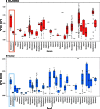Genomic analysis reveals hidden biodiversity within colugos, the sister group to primates
- PMID: 27532052
- PMCID: PMC4980104
- DOI: 10.1126/sciadv.1600633
Genomic analysis reveals hidden biodiversity within colugos, the sister group to primates
Abstract
Colugos are among the most poorly studied mammals despite their centrality to resolving supraordinal primate relationships. Two described species of these gliding mammals are the sole living members of the order Dermoptera, distributed throughout Southeast Asia. We generated a draft genome sequence for a Sunda colugo and a Philippine colugo reference alignment, and used these to identify colugo-specific genetic changes that were enriched in sensory and musculoskeletal-related genes that likely underlie their nocturnal and gliding adaptations. Phylogenomic analysis and catalogs of rare genomic changes overwhelmingly support the contested hypothesis that colugos are the sister group to primates (Primatomorpha), to the exclusion of treeshrews. We captured ~140 kb of orthologous sequence data from colugo museum specimens sampled across their range and identified large genetic differences between many geographically isolated populations that may result in a >300% increase in the number of recognized colugo species. Our results identify conservation units to mitigate future losses of this enigmatic mammalian order.
Keywords: Colugo; Southeast Asia; biogeography; genetics; genomic analysis; phylogenomics; population dynamics.
Figures




Similar articles
-
Efficient cross-species capture hybridization and next-generation sequencing of mitochondrial genomes from noninvasively sampled museum specimens.Genome Res. 2011 Oct;21(10):1695-704. doi: 10.1101/gr.120196.111. Epub 2011 Aug 31. Genome Res. 2011. PMID: 21880778 Free PMC article.
-
Molecular and genomic data identify the closest living relative of primates.Science. 2007 Nov 2;318(5851):792-4. doi: 10.1126/science.1147555. Science. 2007. PMID: 17975064
-
Comparative Phylogeography of Forest-Dependent Mammals Reveals Paleo-Forest Corridors throughout Sundaland.J Hered. 2019 Mar 5;110(2):158-172. doi: 10.1093/jhered/esy046. J Hered. 2019. PMID: 30247638
-
Colugos: obscure mammals glide into the evolutionary limelight.J Biol. 2008;7(4):13. doi: 10.1186/jbiol74. Epub 2008 May 1. J Biol. 2008. PMID: 18466644 Free PMC article. Review.
-
Phylogenetic relations between microbats, megabats and primates (Mammalia: Chiroptera and Primates).Philos Trans R Soc Lond B Biol Sci. 1989 Nov 30;325(1229):489-559. doi: 10.1098/rstb.1989.0102. Philos Trans R Soc Lond B Biol Sci. 1989. PMID: 2575767 Review.
Cited by
-
Evolutionary Models for the Diversification of Placental Mammals Across the KPg Boundary.Front Genet. 2019 Nov 29;10:1241. doi: 10.3389/fgene.2019.01241. eCollection 2019. Front Genet. 2019. PMID: 31850081 Free PMC article.
-
Cathelicidin antimicrobial peptides mediate immune protection in marsupial neonates.Sci Adv. 2025 Apr 18;11(16):eads6359. doi: 10.1126/sciadv.ads6359. Epub 2025 Apr 16. Sci Adv. 2025. PMID: 40238884 Free PMC article.
-
Accurate, scalable, and fully automated inference of species trees from raw genome assemblies using ROADIES.Proc Natl Acad Sci U S A. 2025 May 13;122(19):e2500553122. doi: 10.1073/pnas.2500553122. Epub 2025 May 2. Proc Natl Acad Sci U S A. 2025. PMID: 40314967 Free PMC article.
-
Fossil lemurs from Egypt and Kenya suggest an African origin for Madagascar's aye-aye.Nat Commun. 2018 Aug 21;9(1):3193. doi: 10.1038/s41467-018-05648-w. Nat Commun. 2018. PMID: 30131571 Free PMC article.
-
Recent advances in understanding evolution of the placenta: insights from transcriptomics.F1000Res. 2018 Jan 19;7:89. doi: 10.12688/f1000research.13115.1. eCollection 2018. F1000Res. 2018. PMID: 29416852 Free PMC article. Review.
References
-
- N. T-L. Lim, Colugo: The Flying Lemur of South-East Asia (Draco Publishing, Singapore, 2007), 80 pp.
-
- Lim N. T-L., Giam X., Byrnes G., Clements G. R., Occurrence of the Sunda colugo (Galeopterus variegatus) in the tropical forests of Singapore: A Bayesian approach. Mamm. Biol. 78, 63–67 (2013).
-
- Stafford B. J., Szalay F. S., Craniodental functional morphology and taxonomy of dermopterans. J. Mammal. 81, 360–385 (2000).
-
- K. C. Beard, in Primates and Their Relatives in Phylogenetic Perspective, R. D. E. MacPhee, Ed. (Springer, New York, 1993), pp. 63–90.
-
- Jackson S. M., Thorington R. W. Jr, Gliding mammals: Taxonomy of living and extinct species. Smithson Contrib. Zool. 10.5479/si.00810282.638.1 (2012).
Publication types
MeSH terms
Grants and funding
LinkOut - more resources
Full Text Sources
Other Literature Sources

